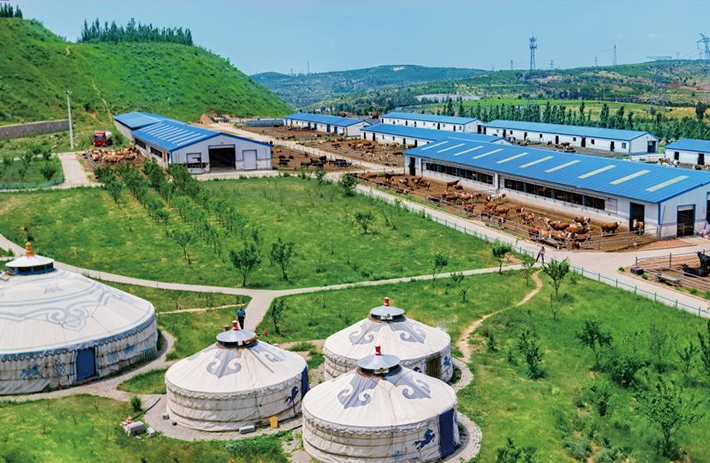
The ecological farm on Zhunneng Group (File Photo)
As the Chinese people across the country prepare to celebrate the upcoming Spring Festival holiday, Liu Zhongyuan, a technician at the Ruichen Wanniu Livestock Farm in Jungar Zhao Town, Jungar Banner, Inner Mongolia, is busy at work.
Unlike conventional cattle farms, Ruichen Wanniu Livestock Farm adopts a new agro-husbandry development model that integrates livestock breeding with photovoltaics, featuring solar power panels installed atop the cowsheds.
The farm is part of a startling transformation this traditional mining area has gone through. Jungar Banner Qi boasts proven coal reserves of 54.4 billion tonnes, with 80 percent of its landmass containing coal. The local mining sector has taken giant steps in terms of green transformation - moving away from traditional coal extraction to green development of coal mines, with eight of the 60 coal mines in the area being designated as national-level green coal mines.
Photovoltaic livestock farms
Jungar Zhao is one of the prominent mining areas of Jungar Banner. According to Wu Yun, chairman of the Jungar Zhao People’s Congress, coal mining had a devastating effect on the local environment, with coal gangue and debris scattered all around.
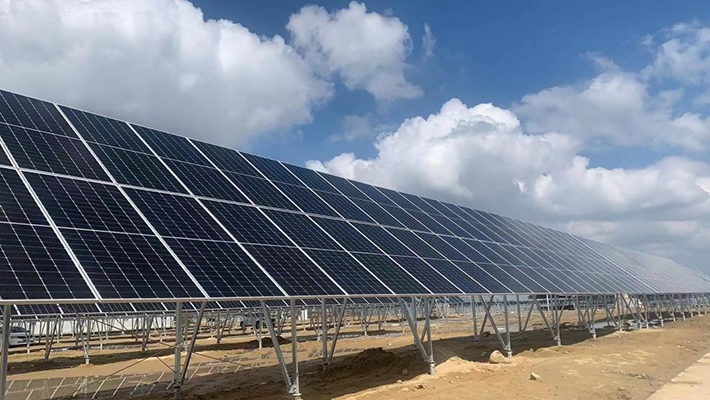
Photovoltaic panels in Jungar Zhao (Wang Shuiquan)
Thanks to extensive ecological restoration efforts spanning several years, the landscape has undergone a remarkable change. Standing atop the viewing platform of the Jungar Zhao green mine, a large swathe of land covered with 4,000 glittering 3-mw photovoltaic panels can be seen.
In order to restore the ecology, the local government has promoted a new model of agriculture and animal husbandry development known as the “integration of husbandry and photovoltaics." This initiative has been exemplified by the establishment of the Ruichen Wanniu Livestock Farm, a collective comprising eight administrative villages and one community, and covering an area of 700 mu (46.67 hectares). Utilising the roofs of sheds and available land, the farm aims to reduce carbon emissions, lower breeding costs, and enhance the collective’s income.
He Xing, director of Ruichen Wanniu Livestock Farm, said that approximately 30,000 square metres of photovoltaic panels have been installed on various structures within the farm, including the roofs of organic fertiliser workshops, cowsheds, and calf raising areas. This setup will ensure stable power generation capacity for at least 15 years.
Elaborating on the benefits, Liu noted, "Compared to conventional roofing, photovoltaic panel roofs provide insulation in winter and shade in summer."
The livestock farm generates over 30 million kwh of electricity annually. The green electricity generated by photovoltaics is utilised in coal mining operations, resulting in an annual cost savings of more than 10 million yuan ($1.39 million), which facilitates the low-carbon green transformation of the coal mines in the region.
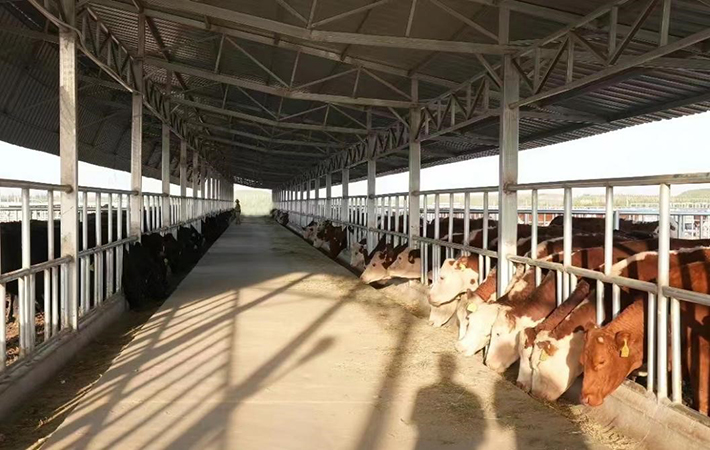
Ruichen Wanniu Livestock Farm in Jungar Zhao Town (Wang Shuiquan)
While green energy is generated from photovoltaic panels, revenue is simultaneously generated from cattle sheds located below the panels.
With a designed capacity of 2,500 cattle stock, the first phase of Wanniu project has repurposed 7,300 mu (486.67 hectares) of reclaimed land. Currently, all sheds have been put into use, with the profit exceeding 10 million yuan ($1.39 million) last year.
"Our next stage of development involves raising 20,000 dairy sheep and 50,000 plateau broiler chickens. Through this business model, we aim to achieve common prosperity," stated director He.
By the end of 2023, Jungar Zhao has constructed four photovoltaic power projects totalling 429 mu (28.6 hectares) with capacities ranging from 3+6 mw to 4 mw. It is anticipated that these projects will save coal mining companies approximately 20 million yuan ($2.78 million) in costs annually.
Fruit harvest from the mine
Xiao Cunhai, a 45-year-old native of Sanbaoyao Village, is among the villagers who traditionally relied on coal mining for their livelihood. Never did he imagine that villagers like him would have the opportunity to earn an annual income of approximately 150,000 yuan ($20,845) as a professional technician in a mine orchard.
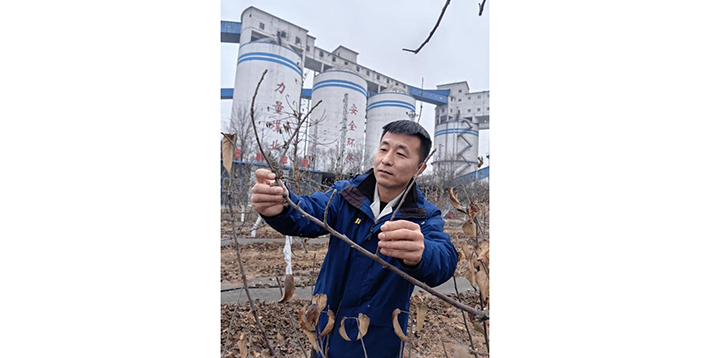
Xiao Cunhai inspects fruit trees in the Dafanpu Coal Mine Reclamation Area (File Photo)
Thanks to the green development project implemented in Dafanpu Coal Mine, Xiao has witnessed a series of remarkable changes in the local environment, including greener mountains, better environmental conditions and an abundance of flowers and fruits.
Dafanpu Coal Mine, affiliated to Kinetic Mines and Energy Corp. in Jungar Banner, Inner Mongolia, commenced operation in 2012, boasting an annual output of 6.5 million tonnes.
In recent years, with the objectives of exploring a reclamation strategy suitable for the region and achieving green development goals, efforts have been made to integrate mining area reclamation with the development of modern agriculture.
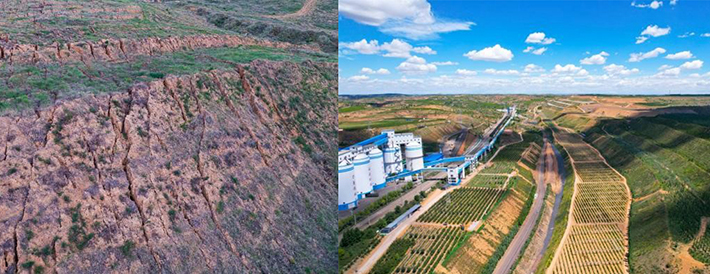
The Dafanpu Coal Mine Area before (left) and after management (File Photo)
In 2018, Kinetic Mines and Energy Corp. established an agricultural company to develop ecological agriculture and restore the ecology of the mining area by planting grapevines, apple trees and vegetables. Xi Ming, executive deputy general manager of the Kinetic Mines and Energy Corp., said, “The purpose of developing ecological agriculture projects in low-lying mining areas is to establish a sustainable green industry for future generations and local communities.” He also mentioned that, as part of this effort, new saplings are planted concurrently with mining activities. This measure ensures that as the saplings mature into trees, the mountains remain green.
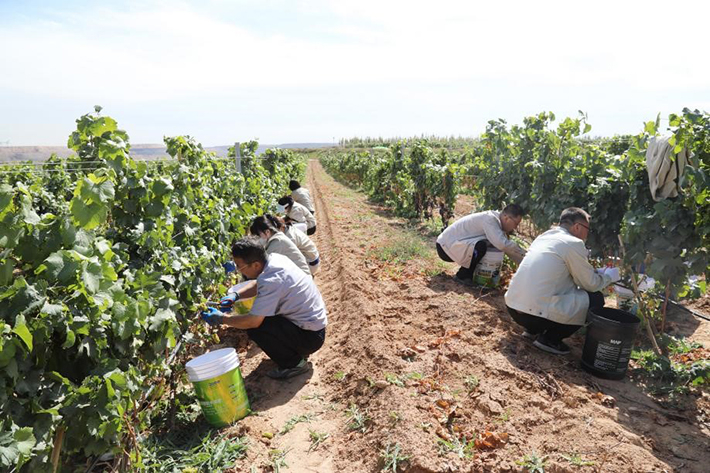
Grape harvesting in Dafanpu Coal Mine Reclamation Area (File Photo)
As for now, the agricultural company has developed 500 mu (33.33 hectares) of vineyard, 600 mu (40 hectares) of orchard, and 100 mu (6.67 hectares) of open-field vegetable planting area and greenhouses within the reclamation area. Additionally, an accompanying winery with an annual output of 200 tonnes has also been constructed. The first batches of dry red and dry white wine were successful produced in 2021.
Rather than pursuing a singular approach to green development, the transformation of the reclamation area has been accomplished through ecological agriculture, which offers ecological, economic and social benefits.
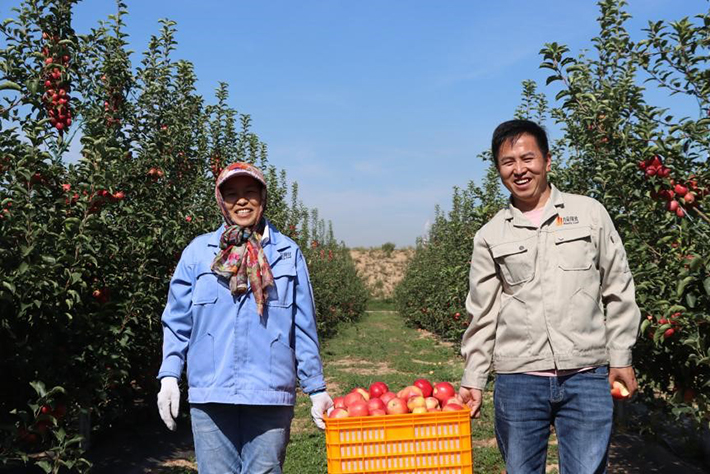
Apple harvest from the Dafanpu Coal Mine Reclamation Area (File Photo)
Xi further elaborated that considering the subsidence of the lowland, the area of apple growing park will increase to 1,000 mu (66.67 hectares) by 2025. The company intends to explore the business model of "enterprise + village collective economy + farmers" and gradually establish village-enterprise cooperatives to drive local prosperity.
Tourist attraction
Located in the heartland of Inner Mongolia, Jungar Banner has become a popular tourist destination despite its relatively underdeveloped transportation infrastructure. Each year, this area draws over 100,000 visitors to its renowned coal mine.
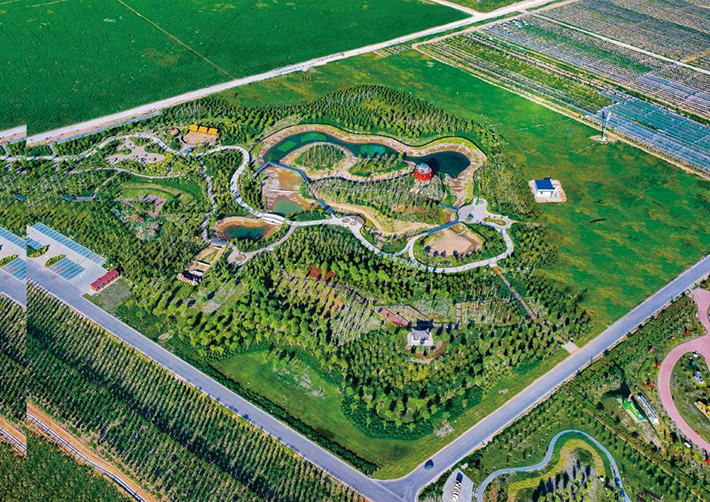
Aerial view of the Zhunneng Industrial Tourism Site (File Photo)
At the Zhunneng Industrial Tourism Site in Xuejiawan Town, Jungar Banner, tourists can immerse themselves in a variety of experiences. They can experience opencut coal mining at the first pit blasting point from 20 years ago in a 3D theatre and through VR interactions. Additionally, they can feel the vitality of modern agriculture at the large orchard, and enjoy the harmonious coexistence of man and nature at the ecological diversity theme park. Even the dining and shopping venues have been repurposed from former giant mining trucks. What were once dirty and dusty mining pits have become tourist attractions.
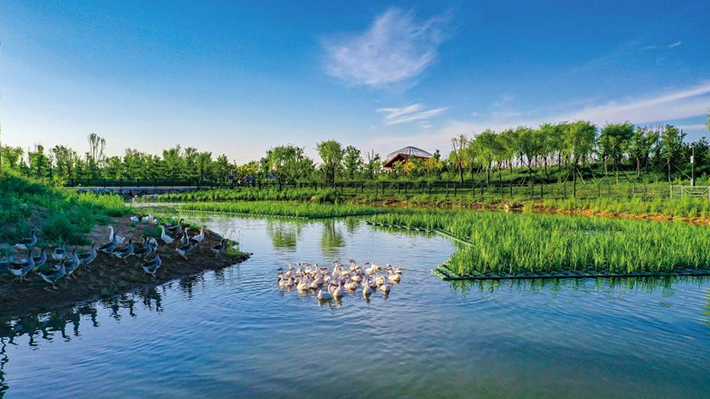
The Zhunneng Biodiversity Theme Park (File Photo)
Zhunneng Group owns two large-scale opencut mines - Heidaigou and Haerwusu, with a total designed annual production capacity of 69 million tonnes, placing them among the top in the country.
Since 2012, Zhunneng Group has intensified its efforts on ecological protection and resource development, gradually transitioning from coal mining to mining tourism. Leveraging its abundant mining heritage, the company has invested nearly 2.8 billion yuan ($389 million) in the reconstruction of cultivated land, plantations, landscapes, and biodiversity protection. Ecological management has been implemented across 65 square km. An industrial tourism site has been established, integrating industrial heritage protection, coal science popularisation, leisure and sightseeing industry. The Mining Area Ecological Restoration Case of Zhunneng Group was highlighted in the 2022 New Nature Economy Report of World Economic Forum, providing scalable experience for the green transformation and development of mines.
"The mining areas are no longer what they used to be. The restoration of land and vegetation has put an end to the dusty air caused by large areas of exposed ground in dumpsites of the mining areas,” stated Wei Bowei, director of the Environmental Protection Department of Zhunneng Group. "The solution of sustainable development of the coal industry lies in and depends on 'ecological green' rather than 'coal black.’"